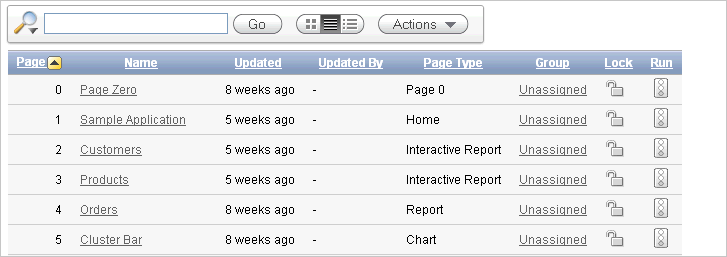
Previous

Next
Home > Using Application Builder > About the Application Home ...
 Previous |
 Next |
To view a specific application, select the application on the Application Builder home page. The Application home page appears. The application ID and the application name display at the top of the page. To link to the application definition, click the Edit Application Properties button.

The following large icons appear next:
Run Application submits the pages in the current application to the Application Express engine to render viewable HTML. See "How the Application Express Engine Renders and Processes Pages".
Supporting Objects links to the Supporting Objects page. See "How to Create a Packaged Application".
Shared Components links to a list of shared components and user interface controls that can display or be applied on every page within an application. See "Working with Shared Components".
Utilities links to the Utilities page. Use this page to monitor developer activity, view dashboards, run Advisor, and view numerous other reports. See "Using Application Builder Utilities".
Export/Import links you to the Export/Import Wizard. Use this wizard to import and export an entire application and related files such as cascading style sheets, images, static files, script files, themes, user interface defaults, and workspace users. See "Exporting an Application and Related Files".
|
Tip: You can control how these items display by clicking Customize Display on the Task list. See"About the Tasks List" |
About the Edit Application Properties and Create Page Buttons
The Edit Application Properties and Create Page buttons display to the right of the application ID and name.
Click Edit Application Properties to edit the application definition. See "Editing the Application Definition". Click Create Page to launch a wizard that walks you creating a page in an application. See "Creating a Page from the Application Home Page".
About the Navigation Bar
A navigation bar displays in the center of the Application home page. You can use these controls to search for pages or customize the page view.

The Application home page navigation bar contains the following controls:
Search icon - Resembles a magnifying glass. Click this icon to narrow your search to only specific columns. To search all columns, select All Columns.
Text area - Enter case insensitive search criteria (wild card characters are implied) and then click Go.
Go button - Executes a search or applies a filter.
View icons. Use this control to toggle between icon, report, and detail view. To change the view, click the following icons:
View Icons (default) displays each application as a large icon identified by the application name.
View Report displays each application as a line in a report.
View Detail displays detailed information about each application.
Actions menu - Displays the Actions menu. Use this menu to customize the report view. See "Using the Actions Menu".
About the Tasks List
A Tasks list displays on the right side of the Application home page.
The Tasks list contains the following links:
Delete this Application deletes the current application. See "Deleting a Database Application".
Copy this Application creates a copy of the current application. See "Copying a Database Application".
Customize Display controls whether the top of the page displays using large icons or small buttons. Options include Use Icons (the default) and Use Buttons.
Understanding Page Display Alternatives
You can control how the Application home page appears by selecting the following icons: View Icons, View Report, or View Details.
View Icons (the default) display each page as an icon.
Report mode displays each page as a line in a report. Each line includes the page number, the page name, when the page was last updated and by whom, the page type, any associated group, and lock status. To view a page, click the page ID. Use the Lock icon to prevent conflicts during application development. Click the Run icon to run the associated page and render viewable HTML.

Details displays detailed information about each page in a separate region. Click the Run icon to run the associated page and render viewable HTML. Click the Edit icon to view the Page Definition. Use the Lock icon to prevent conflicts during application development.

About Recently Edited Pages
The Recent list contains links to recently edited pages within the current application. To link to specific page, click the page ID and name.